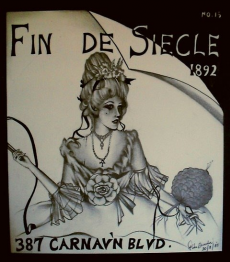
Here’s a phrase you might have heard of, if you read a lot of English Literature or History books from about the turn of the 19th Century. The end of the century (from about 1880 onwards) was a very exciting time, because there was a lot of new ways of thinking emerging in art, literature, music and academia. There’s nothing the fin de siècle didn’t affect, really – even city planning. Fin de siècle really started in France, which clearly explains why the term is in French. It spread very quickly to other European countries, especially Britain and Germany, whose societies had developed rapidly thanks to the onset of the Second Industrial Revolution. These advanced societies created a space for artists, writers and new political thinkers to express their ideas.
This all sounds great, but there was a considerable backlash against it at the time. It was quite closely associated with the “decadent movement”, a free-thinking movement which some people viewed as depraved and immoral. Critics could not stop the physical fin de siècle (i.e. history moving forward from the 19th and into the 20th century), but they could try to stop the cultural revolution that was happening.
But first, the modern world needed to be understood, and that’s why the field of psychology grew rapidly during the fin de siècle. Sigmund Freud and other famous students of the human mind suddenly found themselves (and their theories) in demand.
In Britain at least, the fin de siècle wasn’t very well received, and people certainly weren’t very optimistic about the new ideas it could bring. This was in stark contrast to Romanticism, which was quite optimistic in nature. The decadent movement was more a European group, but England had an equivalent called the Aesthetes, the most famous member being Oscar Wilde himself.
Oscar Wilde and the other Aesthetes broke from tradition, in that they did not think art should be for the purpose of spreading a moral message to the audience. Instead, it was more to make the audience feel something, more like art for art’s sake. Oscar Wilde was Irish, which meant he suffered some racial prejudice. Another issue he faced was that he was gay, and his opponents used this against the whole movement, because they could portray the Aesthetes as morally and sexually wrong and committing a sin, according to the Bible.
The fin de siècle also had a profound impact on feminism. An idea of the “new woman” was emerging in literary circles, and amongst feminists. This “new woman” wasn’t portrayed very well in the media, because it saw her as a challenge to the traditional male hierarchy and the concept of marriage. As with most wide ranging movements, though, nobody was unified on what this “new woman” was, other than the fact she was there to address the huge gap between men and women.
All this is still relevant today, especially with regards to feminism and the gay debate. Oscar Wilde is now one of the most famous writers of modern times, but during the fin de siècle he was criticised on personal grounds, as well as honest criticism. There is an echo of the fin de siècle in the 1990s optimism about the new Millennium, but will we face the same problems as those in the 1910s? Only time will tell.
Image from: http://steampunk.wonderhowto.com/inspiration/end-century-fin-de-siecles-role-steampunk-0140902/

0 Comment:
Be the first one to comment on this article.